
The Palazzo Contarini-Sceriman, also called Palazzo Seriman ai Gesuiti is a 14th-century palace in the Sestiere of Cannaregio of Venice, Italy. It is located near the church of the Gesuiti.

The Palazzo Contarini-Sceriman, also called Palazzo Seriman ai Gesuiti is a 14th-century palace in the Sestiere of Cannaregio of Venice, Italy. It is located near the church of the Gesuiti.
The palace was erected first by the Dolce family in the 14th-century but by the next century belonged to the Contarini family. In 1628 Contarina Contarini, married to Piero Priuli, sold the palace to Alberto Gozzi, a silk merchant. Gozzi would gain access to the aristocracy in 1646, after helping fund the expensive but unsuccessful defense during the Siege of Candia. Gozzi's patronage had also helped erect the Camalodolese convent in San Clemente near Murano, and funded an altar in the church of San Moise.
It was near this palace and the nearby bridge around 1675, that the aristocrat Leonardo Loredan, descendant of a Doge, was found dead in a boat. The unexplained death was the source of many rumors, claiming accidental death, murder by relatives, or murder by the Inquisitors of the Republic.
The palace, had housed for a time the Accademia degli Industriosi, a salon of literature and debate, until it moved to the academy of industrious, before conveyed in Cà Morosini in San Canciano. In 1698 another Alberto Gozzi, descendant of the Gozzi above, endowed the property to the four charitably hospitals in the city, the Incurabili, Pietà, Mendicanti, and the Ospedaletto, in addition to the Monastery of the Convertite. His wife Adriana Dona was allowed to remain in the palace till 1725. The next year, the palace was then auctioned and purchased by Stefano Sceriman. The Sceriman family was originally an Armenian merchant family from Isfahan. Stefano had been awarded Roman citizenship by Pope Innocent XII, and named Count of Hungary by Emperor Leopold I. The family had gained importance in Venice during the 17th century. In 1850, Giovanni Battista Sceriman willed the Palace to the Institute Manin. In 1884, it became home of the Casa generalizia dell'Istituto delle Ancelle di Gesù Bambino. [1]
The palace has undergone a number of reconstructions leading to an eclectic combination of various styles, including Venetian Gothic. Another facade on Rio dei Sartori has similar windows. The main entrance stairwell was painted with the Apotheosis of the Sceriman Family by the school of Tiepolo. [2]

Pistoia (, Italian: [pisˈtoːja] is a city and comune in the Italian region of Tuscany, the capital of a province of the same name, located about 30 kilometres west and north of Florence and is crossed by the Ombrone Pistoiese, a tributary of the River Arno. It is a typical Italian medieval city, and it attracts many tourists, especially in the summer. The city is famous throughout Europe for its plant nurseries.
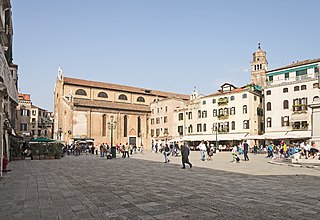
The Chiesa di Santo Stefano is a large Roman Catholic church at the northern end of the Campo Santo Stefano in the sestiere of San Marco, Venice, Italy.

Leonardo Loredan was a Venetian nobleman and statesman who reigned as the 75th Doge of Venice from 1501 until his death in 1521. A wartime ruler, his dogeship was one of the most important in the history of Venice. In the dramatic events of the early 16th century, Loredan's Machiavellian plots and cunning political manoeuvres against the League of Cambrai, the Ottomans, the Mamluks, the Pope, the Republic of Genoa, the Holy Roman Empire, the French, the Egyptians and the Portuguese saved Venice from downfall.
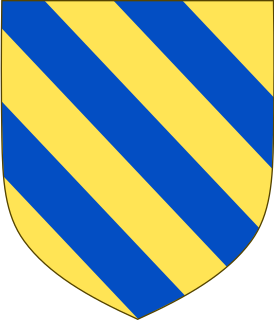
Contarini is one of the founding families of Venice and one of the oldest families of the Italian Nobility. In total eight Doges to the Republic of Venice emerged from this family, as well as 44 Procurators of San Marco, numerous ambassadors, diplomats and other notables. Among the ruling families of the republic, they held the most seats in the Great Council of Venice from the period before the Serrata del Maggior Consiglio when Councillors were elected annually to the end of the republic in 1797. The Contarini claimed to be of Roman origin through their patrilineal descendance of the Aurelii Cottae, a branch of the Roman family Aurelia, and traditionally trace their lineage back to Gaius Aurelius Cotta, consul of the Roman Republic in 252 BC and 248 BC.

The House of Loredan is a Venetian noble family of supposed ancient Roman origin, which has played a significant role in shaping the history of the entire Mediterranean. A political dynasty, the family has throughout the centuries produced a number of famous personalities: doges, statesmen, magnates, procurators, providures, podestàs, military commanders, naval captains, church dignitaries, writers and lawyers.

Armenians in Italy covers the Armenians who live in Italy. There are currently 2,500-3,500 Armenians in Italy mainly residing in Milan, Rome and Venice; another main centre of Armenian culture and history is Padua.

Francesco Loredan was a Venetian statesman and magnate who served as the 116th Doge of Venice from 18 March 1752 until his death in 1762. He was a member of the noble House of Loredan, head of its Santo Stefano branch, and the only Doge to be awarded the Golden Rose by the Papacy.
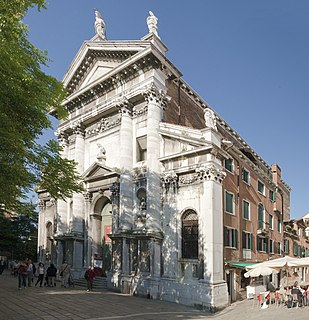
San Vidal is a former church, and now an event and concert hall located at one end of the Campo Santo Stefano in the Sestiere of San Marco, where it leads into the campiello San Vidal, and from there to the Ponte dell'Accademia that spans the Grand Canal and connects to the Sestiere of Dorsoduro, Venice, Italy.
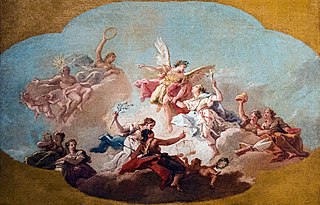
Jacopo Guarana was a Venetian painter of the late Baroque period who was born in Verona. He was active mainly in Venice and its mainland territories.
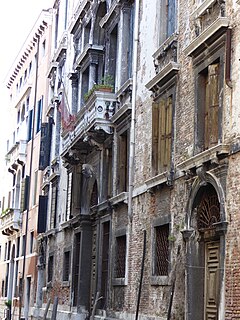
The Palazzo Muti Baglioni is a Baroque architecture palace located near San Cassiano in the Sestiere San Polo of Venice, Italy.

The Palazzo Manfrin Venier, once known as the Palazzo Priuli a Cannaregio or Palazzo Priuli Manfrin, is a Baroque-style palace located facing the Cannaregio Canal in the sestiere of Cannaregio of Venice, Italy. It stands to the left of the Palazzo Savorgnan.
Palazzo di Spagna a San Geremia, also known as Palazzo Frigerio is a palace located on the street Lista di Spagna street #168, once a canal but undergoing landfill in 1844, about midway down the street between the train station and the piazza of the church of San Geremia in the sestiere of Cannaregio, in Venice, Italy. In past centuries, this area of Venice became known for housing foreign embassies, which the secret-obsessed Republic of Venice wished to keep distant from its government buildings.
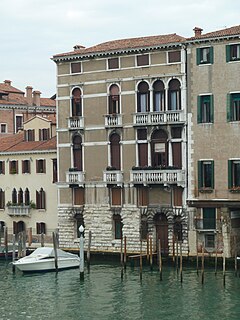
The Palazzo Boldù a San Felice is a palace located on the Canal Grande of Venice, between the Palazzetto Da Lezze and Palazzo Contarini Pisani in the Sestiere of Cannaregio, Venice, Italy.

The Palazzo Loredan Cini is a Gothic-style palace located between the Palazzo Balbi Valier and the Rio San Vio on the Grand Canal, in the sestiere of Dorsoduro, Venice, Italy. The palace was formed from the amalgamation of the former Palazzo Foscari-Loredan with the adjacent Palazzo Grimani. The narrow facade on the Canal has no entrance, but the facade to the north on the Rio, has a single water door, and is connected to the adjacent campo by a bridge. The facade is decorated with two poliforas.

Palazzo Adoldo is a Renaissance palace in Venice, located in the Santa Croce district and overlooking the Grand Canal. On the right there is the church of San Simeon Piccolo, on the left—Palazzo Foscari Contarini.
This is an alphabetical index of people, places, things, and concepts related to or originating from the Republic of Venice. Feel free to add more, and create missing pages.

The House of Loredan-Santo Stefano was a cadet branch of the House of Loredan that existed from the 14th century until 1767. The branch was mainly settled in the Palazzo Loredan in Campo Santo Stefano, which they acquired in 1536 from the Mocenigo family. The progenitor of the branch is considered to be Gerolamo Loredan "dal Barbaro" di S. Vitale (d.~1474), father of Doge Leonardo Loredan and Dogaressa Caterina Loredan. Besides Leonardo, the branch also gave Doge Francesco Loredan.
Caterina Loredan of the noble Loredan family was the Dogaressa of Venice from 1521 to 1523 by marriage to Doge Antonio Grimani.
Francesco Loredan (1656-1715) was a Venetian magnate and nobleman of the Loredan family, and an ambassador of the Republic of Venice to Vienna during the peace negotiations between the Ottoman Empire and the Holy League, which resulted in the Treaty of Karlowitz (1699).

The Palazzo dell'Università or Palazzo Centrale dell'Università di Catania is a monumental palace located in Piazza Universitaria, in the center of the city of Catania, region of Sicily, southern Italy. Since its construction, it has housed the main offices of the University of Catania, and stands across the piazza from the Palazzo San Giuliano, also housing offices of the university. It presently houses the offices of the rector, university offices, the Biblioteca regionale “Giambattista Caruso”, and a small museum of geology and archeology.